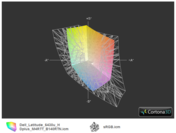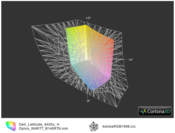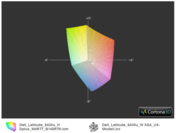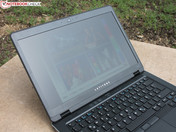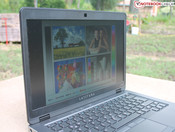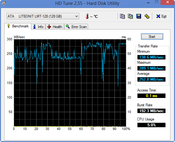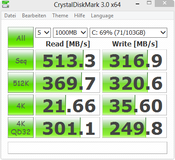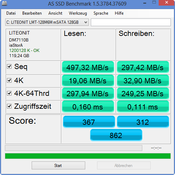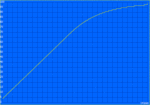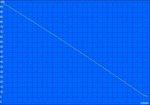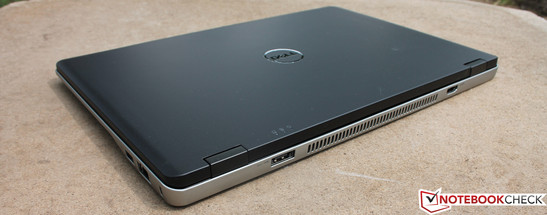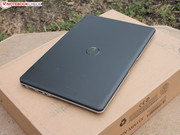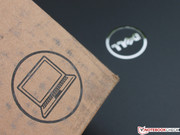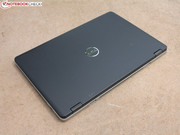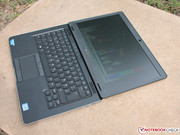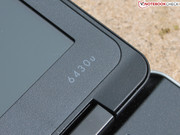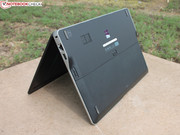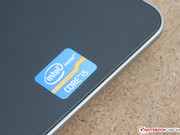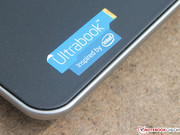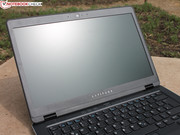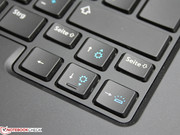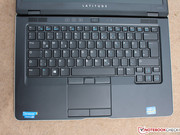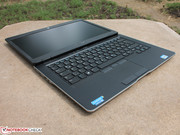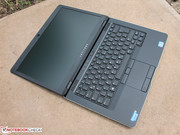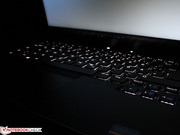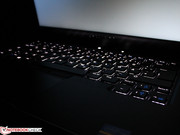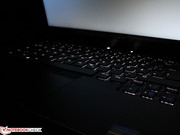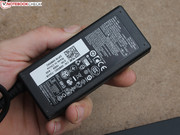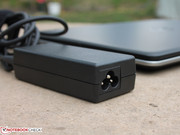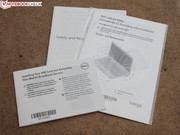Review Update Dell Latitude 6430u HD+ Ultrabook

For the original German review, see here.
Energy-efficient ultrabook hardware has found its way into business machines. More and more manufacturers jump on the bandwagon and offer their ultrabook-variations to the business customer. Lenovo broke the ground with their ThinkPad X1 Carbon (reviewed August 2012), which they followed up with a touchscreen version (March 2013). Lenovo also released the ThinkPad T430u for the less affluent customer around the same time (December 2012). Fujitsu introduced the LifeBook U772 (August 2012) also fairly early, while HP released the Folio 9470m a little later (January 2013).
We reviewed the Latitude 6430u for the first time in January 2013. The US model disappointed more demanding buyers with its rather paltry display resolution of 1366x768 pixels - initially also the only available display resolution offered in some countries. Presumably to compete with Lenovo's ThinkPad X1 Carbon, Dell also now offers a HD+ version. Our review model equipped with said panel currently retails for 1215 Euros (~$1560). Except for the expensive X1 Carbon, none of the competing models mentioned above feature a WXGA++ panel. Samsung's Series 9 900X4B-A01DE (June 2012) and the Zenbook series from Asus (FHD) offer higher resolutions - but those are premium consumer and not business notebooks.
As usual for review updates, we skip some sections and start with evaluating the display. Users interested in the build quality, the ports, connectivity, the mouse and the keyboard, should check out the initial review of the Dell Latitude 6430u. For this review we want to focus primarily on the display and less so on performance, mobility, and ergonomics. Interesting for performance fans though: the Samsung PM830 mSATA SSD (installed in the US model) was replaced by a LITEON SSD LMT-128M6M.
Display
The 14-inch display has a native resolution of 1600x900 pixels and a pixel density of 131 PPI. Compared to the X1 Carbon - which features the same screen size and resolution - the price of admission into the world of HD+ panels is almost a bargain: the version with an i3 processor and 64 GB SSD costs 1140 Euros (~$1465). The comparable 643u version with HD panel (112 PPI) retails for 980 Euros (~$1260). All things considered, the price difference seems worth it.
The TN panel (model M4RTT B140RTN) offers a less than stellar contrast of only 326:1 and a black level of 1.01. The brightness is more of a high point: we measured 332 cd/m² in the middle of the display. Although the brightness decreases on both sides, the distribution of 88% is still very good. The display is also free of halos, spots, or other artifacts.
| |||||||||||||||||||||||||
Brightness Distribution: 88 %
Center on Battery: 261 cd/m²
Contrast: 329:1 (Black: 1.01 cd/m²)
44.71% AdobeRGB 1998 (Argyll 3D)
63.6% sRGB (Argyll 3D)
43.47% Display P3 (Argyll 3D)
The display doesn't handle the professional color spaces very well: sRGB is only covered to about 52%. To determine if the panel is really not suitable for photo editing, we analyze it using both CalMAN software and a photospectrometer.
We measured the panel before (first screenshot each) and after calibration (second screenshot each). Especially around the middle values, the gray levels suffer from a high DeltaE deviation of 11, so grays don't look like they should according to sRGB. A calibration helps: the average DeltaE 2000 is now 5 and the darker grays are represented accurately.
Color accuracy also benefits from a calibration. While cyan and magenta are not close to their ideal values - DeltaE of 13 and 12 respectively - blue is completely off the charts (DeltaE of 18), which results in a strong bluish cast. After calibration, we recorded values of 8, 2, and 15. This means that the bluish cast remains, but magenta (and also yellow, green, red) are much closer to sRGB than they were before.
All in all, the display handles colors less then perfectly. Consumer-oriented notebooks with IPS panels like the Aspire V3-571G are not much better (bluish cast, cyan DeltaE 10) - but the ThinkPad X1 Carbon with its TN panel certainly is better: no bluish cast and all colors except for magenta have a DeltaE value of less than three (after calibration).
When the ultrabook is running on battery power, screen brightness decreases to 261 cd/m² - still sufficient for outdoor use even in sunlight because of the non-glare display panel. However, since the contrast is low, it's a little hard to decipher the screen content. The 6430u doesn't come with an ambient light sensor, which is a plus in our book: all too often the auto-adjustment is quite distracting for the user. The decrease in screen brightness can't be counteracted - Dell doesn't offer a tool or an option in the BIOS to prevent the dimming of the display.
TN panels usually don't do well as far as viewing angles are concerned. However, displays based on IPS and PLS (Samsung only) technology don't exhibit color changes even at fairly extreme angles. The TN panel of the 6430u only handles deviations of up to 45 degrees in the horizontal and 15 degrees in the vertical plane before inversions and ghosting occurs. Two or more people will have a hard time sharing the screen.
The X1 Carbon offers a slightly better viewing angle stability. All aforementioned business ultrabooks don't offer IPS displays. Consumer notebooks, like the Asus Zenbook UX31/UX32 or the Samsung Series 9 900X4B are vastly superior in that regard.
Performance
Our review model is equipped with the middle of the available CPUs - a Core i5-3437U (1.9 GHz). The dual-core CPU has a TDP of 17 watts and can overclock to 2.9 GHz (one core, theoretical limit) using Turbo Boost. The Intel HD 4000 GPU is integrated into the CPU. For technical details, please take a look at the links above.
If lower performance and no Turbo Boost are acceptable, the Core i3-3217U might be an option: the 643u-2669 comes with a 64 GB SSD, Windows 7 Professional and a display with the same 1600 x 900 pixel resolution for about 200 Euros (~$260) less. The top model 643u-5530, which is equipped with a Core i7-3367U, 16 GB RAM, 256 GB SSD, UMTS, and Windows 7 Professional, sells for 1815 Euros (~$2350).
Our review model features Hynix 2 x 4 GB RAM operating in dual-channel mode (maximum: 2 x 8GB). Instead of the 128 GB Samsung PM830 MZ-7PC128D mSATA SSD - installed in our first review model - our version comes equipped with a 128 GB LITEON LMT-128M6M mSATA SSD. We will address the hardware differences in the following sections.
CPU Performance
The Intel Core i5-3437U (1.9 GHz) is an Ivy Bridge processor manufactured using the 22 nm process. The 1.8 GHz i5-3427U installed in our US review model featured a slightly lower clock speed, although that's not really noticeable (-2% Multi-CPU test). The Cinebench R11.5 benchmark tests - single-threaded load (2.7 GHz) and multi-threaded load (2.7 GHz) - show how the CPU uses its Turbo while the ultrabook is connected to external power (see screenshots below)
The CPU Multi-test shows negligible differences in performance between the different processors. Even the Core i7-3667U installed in the X1 Carbon Touch is only about 11% faster. The OpenGL test, which taxes the graphic card, shows larger gaps in performance, even though all mentioned notebooks - except for the Samsung 900X4C - use the integrated Intel HD 4000. Because the RAM operates in dual-channel mode (two RAM modules), the 6430u is the fastest of the bunch. Of all Ivy Bridge ultrabooks mentioned, HP's Folio 9470m is the slowest (-34%).
The less expensive version of the 6430u equipped with Core i3-3217U (1.80 GHz) is about 32% slower (R11.5 Multi 1.8 vs. 2.66 points).
System Performance
We use PCMark 7 and PCMark Vantage to determine the overall system performance. The 6430u does well here - only the Lenovo ThinkPad X1 Carbon Touch completed the PCMark 7 benchmark 5% faster. The X1 is equipped with the Intel SSD 521, which shows almost identical performance in the System Storage Score sub-test. Is the performance difference between the SSDs really as minimal as the System Storage Scores would lead us to believe? We will investigate that in the next section.
| PCMark Vantage Result | 13546 points | |
| PCMark 7 Score | 4925 points | |
Help | ||
| PCMark Vantage - 1024x768 Result (sort by value) | |
| Dell Latitude 6430u HD+ | |
| Samsung 900X4B-A01DE | |
| HP EliteBook Folio 9470m H4P04EA | |
| Fujitsu LifeBook U772 | |
| Lenovo Thinkpad X1 Carbon N3N34GE | |
Storage Solution
The LITEON SSD does its job very well. Only the drives installed in the T430u and the X1 Carbon show slightly better 4K reads (small, dispersed data). The measurements have to be taken with a grain of salt, however, as the different tests can show quite different results (see X1 Carbon non-touch: -20% vs. +13%). Since the manufacturers also change SSD brands and models, it's hard for the buyer to know in advance what exactly they will be getting. For users who don't happen to be performance enthusiasts, it doesn't really matter if the SSD reads and writes at 200 or 300 MB/s - the SSD is going to be significantly faster than any conventional hard drive.
The move to the LITEON SSD definitely was a good choice. The 4K tests show performance gains between 14 and 21% for 4K reads compared to the Samsung PM830 installed in the US version (first test 6430u).
GPU Performance
The HD 4000 - the standard GPU integrated in Ivy Bridge CPUs - operates between 350 MHz (idle) and 1150 MHz when the Turbo is active. Depending on cooling requirements and the manufacturer's settings, this frequency dips slightly during the CPU/GPU stress test - to 1000 MHz in our case. Most competitors show a similar reduction in clock speed.
The GPU offers decent performance due to the dual-channel RAM configuration. Both the 3DMark benchmark tests as well as the OpenGL test (Cinebench R11.5 - see above) show that clearly. Nearly all business notebooks make use of the integrated GPU except for the ThinkPad T430u, which can also be had with a GeForce GT 620M. Since April 2013, Asus offers the Asus Pro BU400VC with an Nvidia NVS 5200M. The performance advantage is not significant - unless the software can make use of the CUDA cores. The drivers for NVS GPUs are designed for business scenarios and therefore more stable.
| 3DMark 06 Standard Score | 5593 points | |
| 3DMark Ice Storm Standard Score | 39397 points | |
| 3DMark Cloud Gate Standard Score | 4211 points | |
| 3DMark Fire Strike Score | 604 points | |
Help | ||
| 3DMark - 1280x720 Cloud Gate Standard Score (sort by value) | |
| Dell Latitude 6430u HD+ | |
| Asus BU400VC-W3040X | |
Emissions
Noise Level
Looking for a quiet notebook? No need to look any further. Both idle and load tests show almost identical results - even at the highest fan setting, the noise tops out at only 33 dB(A). It almost seems like the fan is off during idle - but that's not the case. The spinning fan just happens to be barely audible regardless of the profile used and is thus hardly noisier than our test environment.
Noise level
| Idle |
| 29.9 / 29.9 / 29.9 dB(A) |
| Load |
| 32.6 / 32.8 dB(A) |
 | ||
30 dB silent 40 dB(A) audible 50 dB(A) loud |
||
min: | ||
Temperature
The extremely quiet fan - which never turns off - does a good job removing the heat from the chassis. During idle, both the top and the bottom reach about 30-32 °C (86-89.6 °F). The stress test - which simulates heavy load and taxes both CPU and GPU - is accompanied by a frequency reduction to 1.9 GHz (CPU) and 1050 MHz (GPU) and causes the chassis to heat up to a maximum of 51 °C (123.8 °F). The average is still a very acceptable 36 °C (96.8 °F); the palm rest area stays as cool as it does during idle. The ultrabook can be used on the lap regardless of load levels.
Users don't really have to fear a performance reduction for two reasons. Firstly, the stress test simulates loads that will normally not occur except during some games - and the HD 4000 is the wrong choice for gaming in the first place. Secondly, the Cinebench tests we conducted above also show that the Turbo is active at all times: the CPU is running at 2.7 GHz, the GPU at 1150 MHz. When we conducted a 3DMark06 test after running the stress test for several hours, we saw no reduction in performance due to heat.
(-) The maximum temperature on the upper side is 51 °C / 124 F, compared to the average of 34.3 °C / 94 F, ranging from 21.2 to 62.5 °C for the class Office.
(-) The bottom heats up to a maximum of 49.1 °C / 120 F, compared to the average of 36.8 °C / 98 F
(+) In idle usage, the average temperature for the upper side is 29.8 °C / 86 F, compared to the device average of 29.5 °C / 85 F.
(+) The palmrests and touchpad are cooler than skin temperature with a maximum of 27 °C / 80.6 F and are therefore cool to the touch.
(±) The average temperature of the palmrest area of similar devices was 27.6 °C / 81.7 F (+0.6 °C / 1.1 F).
Energy Management
Power Consumption
During the stress test, the 6430u consumed between 32 and 37 watts depending on the Turbo frequency. The maximum of 37 watts seems unusual at first: this value should be higher than the maximum recorded during the 3DMark06 test (40 watts). Since the frequency never drops below the core frequency, throttling does not occur.
Overall, the results are similar to what we saw during our first test of the 6430u - although the US model (1.8 GHz Core i5-3427U) operated at a lower GPU frequency range from 700-900 MHz. Our review model, on the other hand, always maintained at least 1000 MHz.
The 65 watt power adapter recharged the running ultrabook in 2 hours 21 minutes. The battery is removable just like on the T430u and the EliteBook Folio 9470m. The X1 Carbon and the Asus BU400VC both come with integrated batteries.
| Off / Standby | |
| Idle | |
| Load |
|
Key:
min: | |
Battery Life
During idle, the ultrabook consumes a low-voltage CPU typical 8-12 watts. The competitors are similar - even those with dedicated GPU: the ThinkPad T430u needs 11 watts, the Asus BU400VC requires only 9 watts. We should mention though that these two models feature display panels that are over 100 cd/m² less bright.
The battery life is right in line with what we've come to expect from Latitudes: the 6430u lasts 12 hours during idle (lowest possible power consumption) and 7 hours 29 minutes during our WLAN test (automated surfing using a script). The first 6430u lasted 6 hours and 16 minutes and 3 hours and 25 minutes respectively. The reason was the smaller 3-cell battery with a capacity of 47 Wh. Dell now uses a 60 Wh 6-cell battery; some lower-end models still come with 3-cell batteries.
Verdict
The HD+ version of the Dell Latitude 6430u is a well-rounded ultrabook for business professionals. Because we consider many different factors, the final score only improved by 1% to 86%. The new model doesn't have any major flaws - but adds an improved display to the available options. Some users will certainly appreciate the resolution of 1600x900 pixels and the improved display brightness. The new panel is not perfect, however: the professional color spaces are not adequately covered, the color accuracy isn't very high, contrast is low, the viewing angles are restricted, and the display has a bluish cast.
The competition either doesn't offer panels with HD+ resolution (HP Folio 9470m, Asus BU400VC, ThinkPad T430u) or charges a hefty premium (ThinkPad X1 Carbon). For more HD+ or FHD alternatives, the user needs to consider consumer ultrabooks (Asus Zenbook UX31/UX32, Samsung Series 9 900X4C).
A second improvement: the battery life. The ultrabook with the 6-cell battery now lasts 7 hours 29 minutes during the WLAN test - neither the T430u (3 hours 25 minutes) nor the 3-cell US model of the 6430u (4 hours 34 minutes) get close. The HP 9470m (7 hours 39 minutes), Asus BU400VC (6 hours 25 minutes), and Lenovo X1 Carbon (6 hours 54 minutes) last roughly the same amount of time.
The input devices don't quite reach the high standard set by the Latitude E-series. Although the keys have ample travel, the feedback is somewhat spongy.
The magnesium-alloy chassis is very sturdy - even though the cutout for the replaceable battery weakens the base unit a little. The weight of 1.825 kg with the 6-cell battery is higher than that of most competitors: X1 Carbon (1.5 kg), Folio 9470m (1.64 kg), Samsung Series 9 900X4C (1.66 kg). Only the ThinkPad T430u (1.9 kg) is heavier.
Other positive attributes: the noise levels are very low and the port selection is certainly adequate for the class. Although the 6430u doesn't have a docking port like the Latitude E-series - the only ultrabook in our comparison equipped with one is the HP Folio 9470m - Dell is going to offer WiGig docking shortly. At the time of writing, we don't know the price of the device, which allows connecting input devices, monitors, and other peripherals without any cables.




